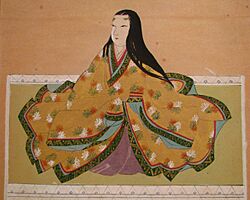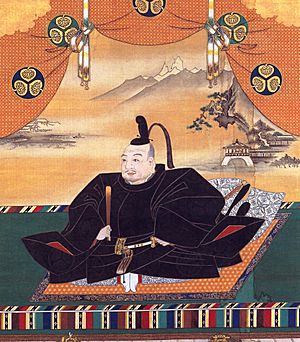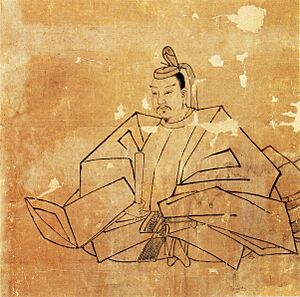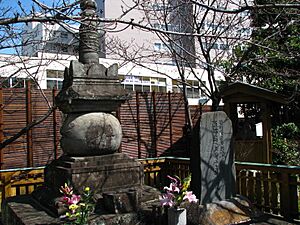Lady Saigō facts for kids
Quick facts for kids
Lady Saigō
Senior First Rank
|
|
|---|---|
| 西郷局 | |

Portrait of Lady Saigō, Hōdai-in, Shizuoka, Japan
|
|
| Born |
Tozuka Masako (戸塚昌子)
1552 Nishikawa Castle, Mikawa, Japan
|
| Died | 1 July 1589 (aged 36–37) Sunpu Castle, Suruga, Japan
|
| Resting place | Hōdai-in, Shizuoka city |
| Other names | Saigō no Tsubone |
| Spouse(s) | Tokugawa Ieyasu |
| Children | 4, including Tokugawa Hidetada and Matsudaira Tadayoshi |
| Parent(s) |
|
| Relatives |
|
| Honours | Senior First Rank of the Imperial Court |
Lady Saigō (西郷局 or 西郷の局 Saigō no Tsubone), born in 1552, was a very important woman in Japanese history. She was a partner of Tokugawa Ieyasu, a powerful samurai lord who brought peace to Japan in the late 1500s. Ieyasu later became the first shōgun, a military ruler of Japan.
Lady Saigō was also the mother of Tokugawa Hidetada, who became the second Tokugawa shōgun. Her contributions were so important that after she died, she received the Senior First Rank from the Emperor of Japan. This was the highest honor anyone outside the Imperial family could receive.
During her time with Ieyasu, Lady Saigō gave him advice on his plans and choices. She helped him rise to power during a time of war, known as the Sengoku period. Because of her influence, she played a part in shaping the Tokugawa shogunate, the government that ruled Japan for over 250 years. Many people see her as the "power behind the throne." Her life story is sometimes compared to a "Cinderella story" in feudal Japan.
Lady Saigō was also known for her kindness. Once she was in a respected position, she used her wealth to help others. She was a devoted Buddhist and gave money to temples. Since she was very near-sighted, she also started a charity to help visually impaired women. Lady Saigō died at a young age in 1589.
Lady Saigō had four children. She had a son (Saigō Katsutada) and a daughter (Tokuhime) from a previous marriage. With Tokugawa Ieyasu, she had two sons: Tokugawa Hidetada and Matsudaira Tadayoshi. One of her descendants was Empress Meishō, who became one of the few women to rule Japan as an empress regnant.
Contents
Understanding Her Name
The name "Saigō-no-Tsubone" is actually a title, not her birth name. She was adopted into the Saigō family, which allowed her to use their family name. When she became an important partner to Tokugawa Ieyasu, the title "tsubone" was added to her name.
The word tsubone refers to the private living areas for high-ranking women in a court. It became a title for women who were given their own quarters, especially important partners who had children with a lord. This title was used for centuries and is often translated as "Lady" in English.
Lady Saigō's birth name was likely Masako (昌子), but this name is rarely used today. Her most common name was Oai (お愛 or 於愛), which means "love." This was a nickname she received as a child. Her close friends and family called her Oai throughout her life. After she died, she was given a Buddhist posthumous name. An abbreviation of this name, Hōdai-in (宝台院), is sometimes used out of respect.
Her Family Background
Lady Saigō's family, the Saigō clan, was a branch of the well-known Kikuchi clan. They moved to Mikawa Province in the 1400s. The Saigō family became loyal supporters of the Matsudaira clan, which was led by Tokugawa Ieyasu. This loyalty was important during a time when many clans were fighting for power.
Lady Saigō's mother was the older sister of Saigō Kiyokazu, who later became the head of the Saigō clan. Her father was Tozuka Tadaharu.
Her Life Story
Early Years and Family Life
Lady Saigō was born in 1552 at Nishikawa Castle. She was probably named Masako soon after her birth. She grew up in the countryside of eastern Mikawa Province and was given the nickname Oai. In 1554, her father died in a battle. Two years later, her mother remarried and had more children.
Lady Saigō married her cousin, Saigō Yoshikatsu, in 1567. He already had two children from a previous marriage. Lady Saigō and Yoshikatsu had two children together: a son named Saigō Katsutada, born around 1570, and a daughter, possibly named Tokuhime.
In 1571, Saigō Yoshikatsu was killed in battle while fighting the Takeda clan. After his death, Oai was formally adopted by her uncle, Saigō Kiyokazu. However, she chose to live with her mother and stepfather.
Meeting Tokugawa Ieyasu
Oai first met Tokugawa Ieyasu when she was about 17 or 18 years old. She served him tea when he visited her family. It is believed she caught his attention then. Later, in the 1570s, a strong friendship and affection grew between them.
Ieyasu had a home built far from where his first wife, Lady Tsukiyama, lived. While Ieyasu's marriage to Lady Tsukiyama was for political reasons, he valued Lady Saigō for her intelligence and good advice. He also enjoyed her calm personality and their shared background from Mikawa province. Many historical texts say she was the "most beloved" of Ieyasu's partners.
Around 1573, Ieyasu began to trust Oai and ask for her advice on important matters. It is thought that their romantic relationship began around this time. Oai is credited with advising Ieyasu before the Battle of Nagashino in 1575, which was a major turning point for Ieyasu and for Japan. She continued to advise him on battles and alliances for many years.
In 1578, Oai moved to Hamamatsu Castle and took charge of the kitchen. She became very popular with the warriors from her home province. They admired her beauty and saw her as a kind and good example of women from Mikawa. She was polite and gentle, but could also be direct or witty when needed.
On May 2, 1579, Oai gave birth to Ieyasu's third son, who would become Tokugawa Hidetada. This news was a surprise, but it made Oai's position very secure. She was accepted as Ieyasu's main partner. Because of her gentle manner and devotion to Ieyasu, she became known by the respectful title Saigō-no-Tsubone, or Lady Saigō.
Later that year, Ieyasu's first wife, Lady Tsukiyama, and their son, Nobuyasu, passed away. With their deaths, Lady Saigō's position at court became even stronger. Hidetada became Ieyasu's heir, meaning he would be the next leader.
Lady Saigō had her second son with Ieyasu, Matsudaira Tadayoshi, on October 18, 1580. In 1586, Lady Saigō was with Ieyasu when he proudly entered the newly rebuilt Sunpu Castle. This was a public way for Ieyasu to show how much he valued her help and how highly he thought of her.
Her Charitable Work
While living at Sunpu Castle, Lady Saigō was a devoted Buddhist. She was known for her kindness and charity. Since she had severe myopia (near-sightedness), she often gave money, clothes, and food to blind women and organizations that helped them.
She even started a school with living quarters near a Buddhist temple. This school helped poor blind women learn to play the shamisen, a traditional stringed instrument. This skill allowed them to earn a living as traveling musicians called goze. These women followed strict rules to maintain a good reputation. On her deathbed, Lady Saigō wrote a letter asking for her organization to continue helping these women.
Her Death
Soon after moving to Sunpu Castle, Lady Saigō's health began to get worse. She died on July 1, 1589, at the age of 37. The reason for her early death was never fully known. At the time, some suspected she might have been poisoned, but no one was ever identified.
By the time she died, Lady Saigō was treated as if she were Ieyasu's official wife. Her remains were buried at Ryūsen-ji, a Buddhist temple. It is said that many blind women gathered at the temple to pray after her death.
Her Lasting Impact
Tokugawa Ieyasu continued his military campaigns and eventually unified Japan. In 1603, he was named shōgun by the Emperor. The next year, he moved Ryūsen-ji temple closer to Sunpu Castle. He attended Buddhist ceremonies there to honor Lady Saigō on the anniversary of her death. To mark the occasion, Ieyasu gave the temple priests his father's katana (sword) and a portrait of himself. These items can still be seen at the temple in Shizuoka city.
In 1628, Tokugawa Hidetada, who was then the retired second shōgun, also attended ceremonies for his late mother. These ceremonies were meant to help her spirit achieve a high spiritual status in Buddhism. He also made sure she was honored as the temple's special patron. Her posthumous name was changed, and the first part of it was added to the temple's name. Today, the temple is mainly known as Hōdai-in (宝台院).
At the same time, the Emperor Go-Mizunoo gave Lady Saigō the name Minamoto Masako. This meant she was adopted into the Minamoto clan, which was connected to the Imperial family. Her status was later raised to Senior First Rank, the highest honor given by the Emperor to people who greatly influenced Japan's history.
In 1938, Lady Saigō's mausoleum (a building for her grave) at Hōdai-in was named an Important Cultural Property. However, the entire temple complex was destroyed in a large fire in 1940. The stone monument over her grave still stands, but you can see the damage it suffered. Many of the temple's treasures, including a portrait of Lady Saigō and the sword and portrait given by Ieyasu, were saved by priests who threw them out of windows before the fire spread. The temple was rebuilt in 1970, and the saved historical items are now on display there.
Important Descendants
Lady Saigō was the ancestor of the line of shōguns that started with her son, Tokugawa Hidetada, and continued for several generations. She also became connected to the Imperial family.
In 1620, Hidetada's daughter, Tokugawa Masako, married Emperor Go-Mizunoo and became an empress. As empress, Masako supported the arts and influenced the next three emperors. Her daughter, Princess Okiko, who was Lady Saigō's great-granddaughter, became Empress Meishō in 1629. She ruled Japan for fifteen years as the 109th monarch and was one of only eight empresses regnant in Japanese history.
See also
 In Spanish: Saigō-no-Tsubone para niños
In Spanish: Saigō-no-Tsubone para niños




